






Smooth Sailing





































Embarking on the open water is an exhilarating experience, flled with the promise of adventure and relaxation. Whether you’re a seasoned sailor or a weekend cruiser, protecting your vessel with proper insurance is not just a choice—it’s a necessity. Explore the reasons why every boat owner should prioritize boat insurance for a worry-free voyage.
The open water can be unpredictable, with unexpected storms, collisions, or other potential accidents. Boat insurance can give you fnancial protection if there is damage to your vessel, providing coverage for repairs or replacement.
Accidents on the water can result in damage to other boats, docks, or even injuries to passengers. Boat insurance offers liability coverage, which can pay for damages or injuries you’re liable for while boating, up to specifed limits, and lawsuit costs if you’re sued. This includes damage you cause to another watercraft or if someone on or near your boat is injured and you’re found to be legally responsible.
Unfortunately, boat theft and vandalism are realities that boat owners face. Boat insurance has comprehensive and collision coverage that can protect you against events outside of your control, including theft and vandalism.
Accidents on the water may lead to injuries for you or your passengers. Boat insurance offers a range of optional medical payments coverage limits, helping to cover medical expenses if you are in an accident or someone is hurt on your boat, regardless of fault.
If you fnanced the purchase of your boat, most lenders require insurance coverage to protect their investment. Having boat insurance not only fulflls these requirements but also gives you peace of mind knowing that your fnancial interests are safeguarded.


Some water municipalities and marinas may require proof of insurance for docking or accessing certain areas. Boat insurance allows you the fexibility to explore different destinations without worrying about entry restrictions.
Emergency towing and assistance
Progressive boat insurance can include optional Sign & Glide® On-Water Towing coverage. If your boat is disabled or breaks down on the water, Sign & Glide® pays for on-water towing, jump starts, soft un-groundings, and fuel delivery.
Wreckage removal
If your boat sinks, Progressive boat insurance will cover the cost of removing your boat from the water (if removal is legally required).
Investing in boat insurance is not just about protecting a valuable asset; it’s about safeguarding the memories, experiences, and joy that come with your on-water adventures. Don’t let unforeseen circumstances disrupt your journey—navigate with confdence, knowing that Progressive boat insurance has you covered. Ensure a smooth and worry-free voyage, because when it comes to your boat, peace of mind is the ultimate luxury.
Scan to get a quote in as little as 4 minutes
learn more.





















By Ben Martin, Editor in Chief
Fishing is a beloved pastime that transcends borders, drawing anglers to new destinations around the globe. Whether it’s the thrill of chasing trophy !sh, exploring pristine environments, or immersing oneself in local cultures, traveling to !sh o ers a unique and enriching experience. But why do so many anglers feel compelled to venture far from their home waters to cast a line? Here are some key reasons behind this phenomenon.
For many anglers, the chance to catch a once-in-a-lifetime !sh is a driving force behind their travels. Di erent regions are home to speci!c species that can’t be found elsewhere. For example, the tarpon-rich waters of the Florida Keys, the salmon runs in Alaska, or the giant trevally in the Seychelles all serve as magnets for anglers. e challenge of targeting these iconic species and the bragging rights that come with landing them o en justify the journey.

requires anglers to adapt and learn. Di erent locations come with unique !shing techniques, such as y !shing in Montana’s rivers, jigging for tuna in o shore waters, or using traditional handlines in tropical locales. Each trip is an opportunity to
friends and family or encounters with local guides and fellow anglers. ese interactions create lasting memories and a sense of camaraderie that extends beyond borders. In turn, the stories and photos from these adventures become cherished mementos, sparking conversations and inspiring others to pursue their own !shing journeys.
Magazine and its digital magazine Magazine have always tried to bring you news and awareness about exotic !shing destinations around the world. Your trips and adventures are an integral part of our monthly compilation process. Your photos, videos and stories about your !shing trips are always welcomed here.

acquire new skills, re!ne existing ones, and deepen one’s appreciation for the art and science of !shing.
Fishing in new destinations allows anglers to experience a variety of ecosystems, each with its unique beauty and challenges. From tranquil mountain streams and sprawling freshwater lakes to turquoise saltwater ats and deep ocean trenches, the diversity of !shing environments is staggering. is variety not only enhances the adventure but also broadens an angler’s understanding of aquatic habitats and their importance to global biodiversity.
Traveling to new !shing destinations o en
Fishing inherently fosters a deep connection with nature, but traveling ampli!es this experience. Anglers o en !nd themselves in remote, untouched locations where the tranquility and beauty of the natural world are at their peak. is immersion provides a welcome escape from the stresses of daily life and fosters a sense of mindfulness and gratitude.
Fishing trips o en bring people together, whether it’s through shared experiences with
For many anglers, !shing is more than a sport—it’s an adventure. Traveling to new destinations satis! human desire to explore the unknown and conquer its challenges. Whether it’s navigating unfamiliar waters, encountering unpredictable weather, or matching wits with elusive !sh, each trip is a thrilling chapter in an angler’s personal story. e reasons anglers travel to as diverse as the destinations they seek. From the pursuit of trophy catches to the joy of exploring new landscapes, each journey o ers a blend of excitement, education, and enrichment. For those who !sh, the world is not just a playground but a treasure trove of opportunities waiting to be discovered. So, pack your gear, book that trip, and embrace the adventure—the next big catch might be just a plane ride away.
To submit your catch photos, videos or stories, email editorial@coastalanglermagazine.com.
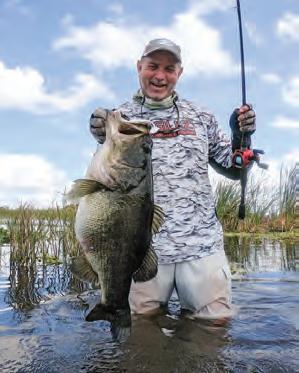















You want new charts?
You got new charts! Explore the ocean with vibrant terrain & depth shading, using all-new TZ MAPS. Don’t just take our word for it. See for yourself. Scan here, and we’ll show you!

What started as a morning of unproductive wahoo trolling north of St. Augustine turned into an unforgettable battle with one of Florida’s most prized catches. Capt. Daniel Levesque and his crew aboard Rare Breed had spent hours searching for wahoo, battling against an uncooperative west wind, when they decided to switch tactics.
“A er passing over endless schools of blue runners and proli!c bottom structure, I pulled into a spot that had previously produced wahoo,” recalls Capt. Daniel. “ e sonar was marking !sh from top to bottom.”
By Brandon Shoaf


As two anglers at the bow dropped sabiki rigs to collect live bait, their lines became hopelessly entangled. While the captain worked to untangle the mess of braided line, angler Mike Lorenz noticed something interesting on the sonar screen. He dropped down an old, paint-worn butter y jig to about 60 feet.
“It got hit by what felt like a train,” Lorenz describes. “ e conventional reel was screaming. At !rst, I thought I had a shark, but it felt di erent.” e mystery !sh made several blistering runs, nearly spooling Lorenz’s reel multiple times. e battle switched between long runs and deep, powerful dives under the boat. “It felt more like !ghting a huge grouper when it was beneath us,” says Lorenz. “I think both the !sh and I were taking breaks between rounds.”
Capt. Daniel maneuvered the boat to help chase down the !sh. A er an
9.9/15/20
These compact yet powerful engines have all the features you would expect to see on larger outboards, such as bettery-less EFI technology, multi-function tiller handle* and a large displacement porviding outstandng power. All while maintaining lightest in its class, quiet opetration and ease of portability.
intense !ght, a massive silver ash appeared near the surface, prompting the captain to shout “AP!” e prize—a massive African pompano—was !nally secured with a well-placed ga shot by Capt. Daniel. e crew gathered for photos, marveling at their spectacular trophy, a testament to both the !sh’s size and the memorable nature of the catch.
What began as a “cursed” day of wahoo !shing transformed into the catch of a lifetime, proving once again that sometimes the best !shing stories come when plans go sideways and anglers remain ready for whatever opportunity presents itself.
Brandon Shoaf is Co-Publisher of Coastal Angler Magazine’s Volusia County edition. Contact him at (386) 260-9600 or volusia@coastalanglermagazine.com.




















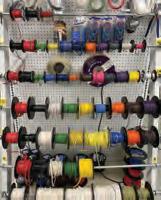



















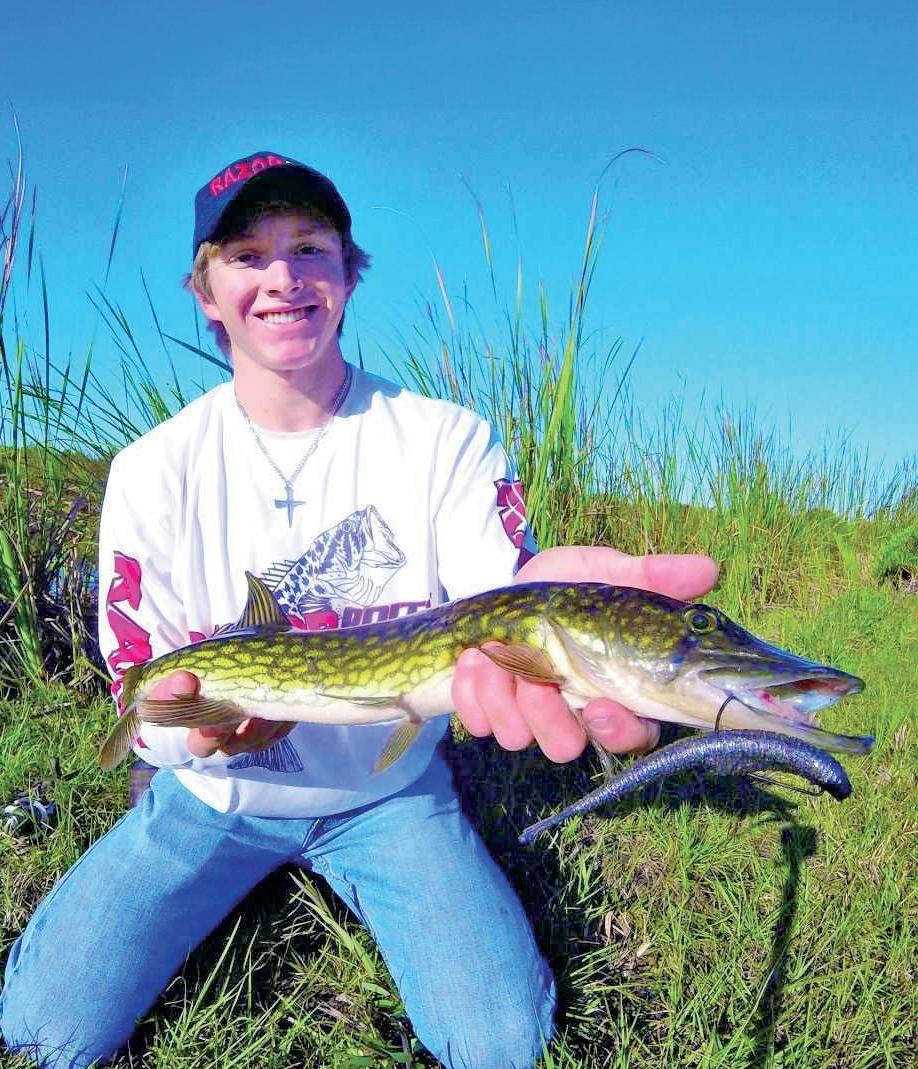
By Brandon Tourigny
In the northern parts of our great country, anglers enjoy chasing down enormous pike and elusive musky. We Floridians don’t usually give this toothy family of sh a second thought since the lake monsters of the north are nowhere to be found in our waters. ere is, however, a smaller cousin of northern pike and musky that Florida anglers willing to do a little searching can have the pleasure of shing for: the chain pickerel.
Named for their greenish and dark colorations creating a chainlike pattern, these sh stand out among the pike family. Alongside their smaller relative, the red n pickerel, these are the only pike family members commonly found in Florida.
Chain pickerel are found statewide and most o en inhabit densely vegetated areas of ponds, swamps and rivers. ese predatory sh are solitary hunters that prowl the shallows in search of small minnows and shad. e chain pickerel’s lightning-fast strikes and long snake-like body make for an exhilarating battle on lighter tackle. e best place to start in terms of selecting baits would be to go with small Rapala jerkbaits and crankbaits, topwater plugs and spinnerbaits. To be able to fully appreciate the ght in these feisty predators, a good rod and reel set up would be a medium-light action spinning rod paired with a 2,500 to 3,000 size spinning reel spooled up with 10- to 20-pound braided line. Don’t be surprised, however, if these toothy sh cut you o$ on occasion. eir mouths are full of needle-sharp teeth that can tear through shing line, and your ngers, very easily.
If you are looking to gain some recognition for your chain pickerel, be sure to check out the Florida Fish and Wildlife Conservation Commission’s big catch program, which gives wellearned recognition to large sh of a number of species caught in Florida. In terms of chain pickerel, any sh 3 pounds and heavier will qualify for this program. Also, as I always like to remind anglers across Florida, these sh are a native species to our state and deserve our respect when shing for them. Try to return sh unharmed to the water as quickly as possible to ensure your catch can continue to grow and carry on the population so our children a er us can have the chance to catch these magni cent sh.
Recommendations include $30 million to Restore Apalachicola’s Oyster Habitat, $10 Million for Shooting Sports Facilities, and $10 million for Artificial Reefs
Governor Ron DeSantis recently announced his 2025-26 Focus on Fiscal Responsibility Budget recommendations, solidifying Florida’s status as the nation’s leader in sh and wildlife conservation and outdoor recreation.
“Governor DeSantis’ recommendations reinforce his unwavering support to Florida’s sheries, hunting and angling community, public access to shooting sports, and the long-term recovery of the Apalachicola Oyster Habitat,” said FWC Executive Director Roger Young. “ ese investments are in addition to the Governor’s law enforcement pay plan, support of enhanced training capabilities for FWC O cers, and funding to bolster our operations to combat illegal immigration and drug tra cking.”
Florida is home to some of the country’s premier destinations for top-tier shing, hunting, and outdoor recreational opportunities. ese activities draw outdoor enthusiasts to our state and contribute signi cantly to the state’s economy with nearly $15 billion dollars. With more than 34 million acres of public and private land and over 12,000 square miles of water, maintaining our sh and wildlife resources is critical to sustaining a healthy way of life and a robust economy.
• Restoring Apalachicola Bay Oysters:
Historically, nearly 90% of Florida’s and 10% of the nation’s wild oysters came from Apalachicola Bay. is year, the Governor is recommending $30 million in funding to expedite FWC’s e$orts to restore and recover the oyster habitat. is investment is in addition to an additional $10 million investment in the Department of Environmental Protection’s budget to invest in projects that support the Apalachicola Bay Area of Critical State Concern.
• Promoting Floridians’ Access to Public Boat Ramps: As the Boating Capital of the World, Florida’s coastal communities must have enough publicly accessible boat ramps. As such, the budget recommends $9 million to increase public access to maritime facilities while providing another year of %exibility in the Department of Environmental Protection’s Working Waterfronts program.
• Investing in Florida’s Arti cial Reefs: e Focus on Fiscal Responsibility Budget provides $10 million to support additional reefs across Florida’s coastlines.
• Increasing Public Access to Shooting Sports and Wild Game: e Governor’s Budget invests $9.2 million to support the construction of two new shooting sports facilities in Liberty and Polk counties while also calling for a “Second
Amendment Summer” tax holiday on rearms and ammunition. Additionally, the budget provides $9 million to manage FWC’s wildlife management areas.
• Prioritizing Fresh and Saltwater Research and State Management: As recommended by the Governor, FWC is provided additional funds to support FWC’s marine lab in Cedar Key and increased funding to support the management of Red Snapper o$ all of Florida’s coastlines. e budget also prioritizes investments in Florida Bass, Snook, Tripletail, and other Bone sh species.
• Defending Florida’s Everglades from Invasive Species: Governor DeSantis includes more than $3 million to remove pythons from the Everglades utilizing traditional methods and innovative technologies.
• Maintaining Law & Order: e Governor provides $5 million for a dedicated state training facility for waterborne rescues and $4.4 million to codify the FWC’s Special Immigration Law Enforcement Unit.
FWC’s mission is to manage sh and wildlife resources for their long-term well-being and the bene t of the people. To learn more about FWC, visit MyFWC.com.


March 19th to March 23rd

Since 1982, the Palm Beach International Boat Show has grown to occupy a dominant position in South Florida as both a leader in the boating and marine industry, and as an economic engine to the Palm Beach community and the tri-county area. THERE IS NO BOX OFFICE ONSITE AT THE SHOW.

Owned by the Marine Industries Association of Palm Beach County and produced by Informa Markets, the Palm Beach International Boat Show will be taking place along Flagler Drive in downtown West Palm Beach, directly across the Intracoastal Waterway from Palm Beach Island.
Ths year’s boat show will be integral in providing visitors, exhibitors, and the community at large with an unforgettable event featuring more than $1.2 billion worth of yachts, fishing boats, and accessories, including hundreds of boats ranging from 8-foot inflatables to superyachts nearly 300 feet in length. From the VIP experience to the AquaZone, there will be activations that cater to all ages and adventure-seeking lifestyles.

Please purchase your digital tickets in advance at the EventsPass website. Children under 6 are free when accompanied by a ticketed adult. Active military and veterans receive complimentary general admission on Sunday, March 23rd. Email cxteam@informa.com or bring your Military ID to the show to collect your ticket.
Link here: https://www.eventspass.com/event/2025PBIBS?pr=WEB/#/buyTickets


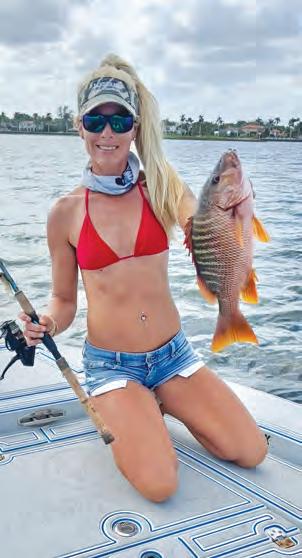
Please be sure to check out my YouTube Channel “Darcizzle Offshoe” for fishing videos eery week! www.youtube.com/DarcizzleOffshoe
I caught this keeper dog snapper on a D.O.A. TerrorEyz. When I don’t have live bait, D.O.A. Lures are my go-to artificial bait!
inally, March madness has arrived which means the fishing should offer plentiful fish catching action for a wide variety of species inshore and offhore this month! The sea temperatures will be slowly warming, and cool fronts will begin to fizzleout as the month progresses. The wind will be your biggest rival because March is considered a transitional month as we head into the beginning of spring. Offhore, sailfish will be a likely catch in the beginning of March, but large numbers of migrating sails are already south of Palm Beach waters. On the bright side, the mahi mahi bite should improve. If we have a steady easterly wind, this should prompt you to rig some ballyhoo and head offhore. Look for conditions such as edges, temperature breaks, rips, and debris.
On the beach, spinner shark migration will be relatively easy to locate. Scan the beach and drive your boat along the coast especially between Palm Beach Inlet and Jupiter Inlet looking for jumping sharks. Ths area is the hot spot where these agile, small sharks will be hanging out and feeding. Once located, start chumming and get some baits out. Live bait is great but chunks of jack crevalle, bluefish, bonita, and barracuda will work. You should be looking for sea turtles and large sharks in shallow water too, as cobia will be following them! Bottom fishing and jigging the deep-water wrecks offBoca, Boynton, or Palm Beach will yield big fish like amberjack, kings, mutton snapper, Spanish mackerel, grouper, and wahoo. Wreck fishing brings the element of surprise, you never know what you will catch.
In the ICW and inshore waters, there will be plenty of inshore action for anglers to enjoy. Snook season has been open for a month already so get out there for your slot fish (28-32” on Florida’s Atlantic coast). Live bait is best; mullet if you can fid them, pilchards, or just live shrimp rigged on a jig from a local shop. Find some moving water or current, and throw that live bait or artifical under the docks, against seawalls, pilings, bridges, etc. For snook and tarpon, I like to use Yo-Zuri Crystal Minnow Lip Divers, trolling or just casting around structure. If the water is dirty, use dark colored lures, and if the water is clear, use light colored artifical lures. Say hello if you see us on the water and until next time, keep on catchin’!
































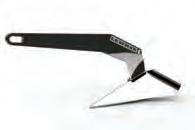







































By Keith Lozott Contributing Writer
Typically, I don’t believe in superstitions, but a˜ er a recent ÿ shing trip with my buddy Neil, I may be a believer!!! ˛ e morning started slow; I caught a small snapper and small snook. Neil was in skunk mode, so we decided to try a spoil island where I’ve caught some trout, snook, and a gag grouper on a prior trip. To our dismay it was dead as well. Just as we were about to exit stage le˜ , Neil was working a topwater lure back to the boat when what appeared to be a large bull shark came up from the bottom and tried to hammer the lure. Unbelievably it totally missed the lure and disappeared. It was impressive to witness such a big specimen of a ÿ sh take a swipe at the lure.
www.swamptosea.com • 561-503-0848


IA˜ er the “Shark Week” experience, we continued to struggle so I decided to implement Plan C and move from the east side of the Indian River to the west side. I’ve had some nice ÿ shing on the west side with trout, reds, and snook. We made our way across the river stopping at another spoil island only to be greeted with a jack attack. I landed several jacks and Neil hooked one that got o˝ . His skunk was still intact but with jacks around I ÿ gured that would change. Unfortunately, that wasn’t the case.
By Keith Lozott Contributing Writer
Typically, I don’t believe in superstitions, but a˜ er a recent ÿ shing trip with my buddy Neil, I may be a believer!!! ˛ e morning started slow; I caught a small snapper and small snook. Neil was in skunk mode, so we decided to try a spoil island where I’ve caught some trout, snook, and a gag grouper on a prior trip. To our dismay it was dead as well. Just as we were about to exit stage le˜ , Neil was working a topwater lure back to the boat when what appeared to be a large bull shark came up from the bottom and tried to hammer the lure. Unbelievably it totally missed the lure and disappeared. It was impressive to witness such a big specimen of a ÿ sh take a swipe at the lure.
A˜ er the “Shark Week” experience, we continued to struggle so I decided to implement Plan C and move from the east side of the Indian River to the west side. I’ve had some nice ÿ shing on the west side with trout, reds, and snook. We made our way across the river stopping at another spoil island only to be greeted with a jack attack. I landed several jacks and Neil hooked one that got o˝ . His skunk was still intact but with jacks around I ÿ gured that would change. Unfortunately, that wasn’t the case.

We used the trolling motor to quietly make our way towards the mangroves hoping to get a glimpse of a red, snook, trout, ˙ ounder, or any inshore species willing to bite. As we approached the shore, we noticed another bull shark working the shore and of course I had to make a cast or two at him, but he had no interest in my o˝ ering. We kept working the shore and ÿ nally it happened for Neil!!! He made a long cast and almost as soon as the lure hit the water, he was on with a nice ÿ sh, but we couldn’t see what it was. He started gaining ground getting it closer; enjoying the ÿ ght and then it happened! ˛ e ÿ sh came unbuttoned and at this point I was like dude, what did you do in a previous life to deserve this??? We made our way toward a dock that I know holds snook. I made a long cast and right then I was hooked up with a huge ÿ sh. It was a big snook; I got her to the boat, revived her, and released her to ÿ ght another day. Success! I said, “let’s go to lunch and call it a day”. I asked Neil if he was hungry and then he disclosed to me that he ate a banana for breakfast! Neil knows not to bring bananas on the boat (it’s bad luck), but it didn’t occur to him that the curse would remain in e˝ ect with it digesting in his stomach. Myth conÿ rmed or was it bad luck? He should’ve brought his lucky rabbit foot!!!
Jacks are always a crowd pleaser.
t is springtime and that means one thing as far as the fishing goes, Big Fish! In March we get a mullet run that is smaller than the major fall run but I believe it makes for better fishing. It is typically very windy the next couple months but if you tough it out there’s going to be some giant snook and jacks waiting for you to deliver a nice fat mullet to the seawall for them. On days when the conditions allow it, slow trolling a live mullet offhore is a great way to produce some amazing action. None of the big pelagics will turn them down and it can be an awesome show watching a sailfish trying to catch a mullet on the surface. Light tackle is still a great option with pompano, sheepshead, ladyfish, and bluefish around. Goofy jigs, spoons, and even small topwaters are good choices.
Jim sight fished this verglades goliath on fl.
We used the trolling motor to quietly make our way towards the mangroves hoping to get a glimpse of a red, snook, trout, ˙ ounder, or any inshore species willing to bite. As we approached the shore, we noticed another bull shark working the shore and of course I had to make a cast or two at him, but he had no interest in my o˝ ering. We kept working the shore and ÿ nally it happened for Neil!!! He made a long cast and almost as soon as the lure hit the water, he was on with a nice ÿ sh, but we couldn’t see what it was. He started gaining ground getting it closer; enjoying the ÿ ght and then it happened! ˛ e ÿ sh came unbuttoned and at this point I was like dude, what did you do in a previous life to deserve this??? We made our way toward a dock that I know holds snook. I made a long cast and right then I was hooked up with a huge ÿ sh. It was a big snook; I got her to the boat, revived her, and released her to ÿ ght another day.

every winter and the fist spawn is our best chance of letting the population grow a bit. Please try to use good judgement.
Good luck out there!
Keith Lozott The Fishing Realtor
Success! I said, “let’s go to lunch and call it a day”. I asked Neil if he was hungry and then he disclosed to me that he ate a banana for breakfast! Neil knows not to bring bananas on the boat (it’s bad luck), but it didn’t occur to him that the curse would remain in e˝ ect with it digesting in his stomach. Myth conÿ rmed or was it bad luck? He should’ve brought his lucky rabbit foot!!!
Keith Lozott The Fishing Realtor

tuesday special 1:00pm-7:00pm (6-hours)
$80.00 per person
Sailing two trips daily, 7 – days a week! 8am – Noon • 1pm - 5pm (Tuesdays 1-7pm) Night trips – Wednesday & Friday 6pm – 10pm seasonally – call for more info. Plenty of free PArking very close to the boAt! give us a try and see what everybody is raving about! We put the “FUN” back into drift boat fishing! so sit back, relax you’re on island time!
fish tripsBoth tuesdayoN $130 per person





By Jeremy Wallace, Co-Publisher
If you are reading this, it will be a few weeks since my dad passed away on us. My dad, Steven Wallace, was everyone’s best friend and the reason behind who I am today. My dad had so many passions in life, but fishing was paramount and has been shared between my grandfather Robert, my dad, myself, and my son Jackson. Ths is now four generations who truly love any day on the water. It started with my grandfather, Captain Bob he was known well all-around Brooklyn, New York, and the Sheepshead Bay Tuna Club, where he introduced this sport to my dad. They became 6-time champions of the USATT (United States Atlantic Tuna Tournament), which was a big deal back in the 70s and 80s. My grandfather would be at the helm on his 38’ Pacemaker with most times my dad in the fihting chair reeling in these monster bluefintunas for 2-3 hours plus; one tournament winner weighed in at 693 pounds. I started joining my grandfather and dad and their cast of friends as we took the long seven-hour journey from the South Shore of Long Island to Montauk and then to Block Island for these tournaments at age 7. They treated this shy innocent boy like a young man and as one of them. Nu-Life, the name of the boat, after my grandfather and dad’s successful business of dental labs, would continuously get awards each summer



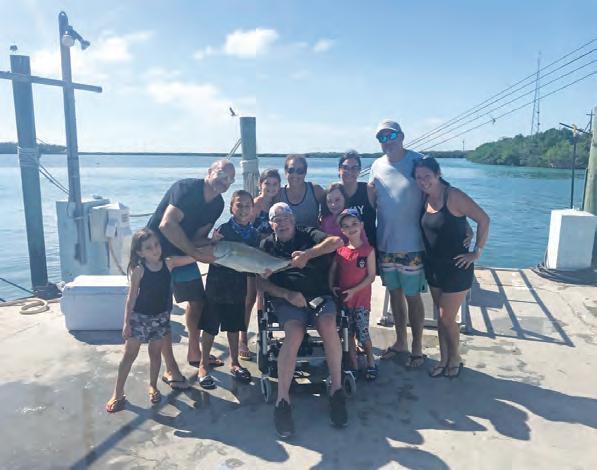
with write-ups in the New York Times and Newsday for winning once again. These are still clear memories for me that seemed to have happened just yesterday. Back to my dad, the man who could befriend anyone even a stranger amongst strangers, will be missed by so many that crossed his path. Ths was not just a loss to my mom, sister, wife, brother-in-law, and his 5 amazing grandkids, but all his close buddies that share the same deep memories of fishing trips and of just being great life-long friends, you “guys” know who you are. My “pops” as I would call him most times, was such a tremendous influence on me and I will always continue to strive to equal him. Everyone that knows me can attest that all I wanted to be, and happily so, a mirror of my father the way he lived and loved life and treated people. From his season tickets back in the day to the New York Islanders and that still being my favorite team and sport to play. Now publishing a fishing magazine due to all our times together with rod and reel in hand. Naming my son Jackson because of our times cruising in his Porsche 911 together listening to Jackson Browne. So, thank you dad to the deepest depths of the oceans for being such a cool dude, father, husband, grandfather, and best friend.




Hello everyone and welcome to the start of spring! There’s always lots going on this time of year here in South Florida. And as we approach the end of manatee season locally, I thought it’d be a good time to check in on our offial state marine mammals to see how they’re doing.
Florida is lucky enough to have a year-round population of manatees. Most years, our winter manatee population grows signifiantly as manatees who venture further north into Georgia, the Carolinas, and beyond return south looking for warmer waters.
Manatees tend to be creatures of habit, and many will stay wherever they are as long as there’s plenty of food and reliable water temps. That’s one of the reasons they love Florida’s spring fed lakes, rivers, and our tidal coastal areas.
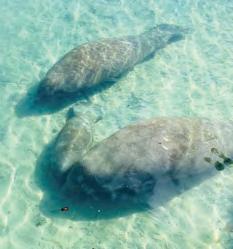
Sadly, you might remember that a few years ago Florida experienced what was called an “unusual mortality event” involving manatees along Florida’s east coast.
Manatees were dying at unprecedented rates, far higher than typical. State offials quickly traced the problem to a lack of food (seagrass) in the Indian River Lagoon. And while more than a thousand manatees unfortunately died of starvation-related causes, the state was able to introduce an innovative manatee feeding program to help sustain Florida’s manatees over the short

term, buying time to allow seagrasses to regrow.
The good news is that manatees are once again doing okay. Forage areas have regrown a bit and manatee mortality in Florida is back in line (even slightly lower) than the five-year average. The less-good news is that we really have no idea whether it will stay that way. Like any living creature, manatees have a life expectancy. Under ideal circumstances, they’re thought to live to more than 60 years. But their lifespan can be cut short by all sorts of things - injuries, disease, prolonged exposure to low temperatures, predation, lack of food, and lack of clean water, among others. Sadly, lack of clean water and food often lead to other issues or death.
If the unusual mortality event of several years ago taught us anything at all about manatees - and I like to think it did - it’s not just that we can feed large groups of manatees and prevent starvation the next time large areas of seagrass die off
It’s that clean water and plentiful food are just as important for manatees as they are for all living creatures. Despite their many excellent attributes, manatees cannot devise and implement strategies for improving water quality. That’s on us, the humans. We know how. The question is...will we?
Just something to think about the next time you see one of these gentle giants out in the wild. Hope to see you on the water!






Fishing rods, reels, tackle boxes, lures, lead, coolers, marine art & decor, and assorted fishing & boating accessories.
Marine & boating related items are still being accepted. Call the Fishing Club @ (561) 832-6780 to donate prior to the event.








March is one of my favorite times to look for tripletail. Using the sun to your advantage you can see tripletail hanging around crab buoys and channel markers. Tossing a D.O.A. Shrimp or a live shrimp around these targets will get you a bite. Pompano will still be along channel edges near your favorite inlets. I like to fish for pompano in the morning and then head to look for tripletail. Both pompano and tripletail can be caught using a D.O.A. Lure 2.75” Shrimp. Switch to the 3” D.O.A. Shrimp if you need the bait to stay in the strike zone a little longer and it won’t sink as fast.



We should start to see more mahi in March. Springtime mahi usually are on the bigger side compared to the fall run. Look for fish to be in the 10-25 pound range. Mullet, pilchards, and goggle eyes are great live bait options. It is also a really good idea to have a pitch bait rigged with your favorite artifical lure. I like a D.O.A. Bait Buster or TerrorEyz. Try slow trolling baits 80 to 300 feet of water. Look for any current edge of weeds to up your chances for a bite. As always, don’t count out hooking into a sailfish or kingfish trolling the same depths.
Peacock bass and clown knifefish will be chewing this month. Prop baits will work well for peacock along shallow edges. Try twenty-pound leader and a 2/0 circle hook casting in and around structure and weed lines to get onto a few clowns with shiners or shad. Look to fish the midwater column and below by adding a pinch weight to your leader and get that bait in their face
Check out Pushin’ Water Kayak Charters on Facebook, YouTube, Instagram, and TikTok for all the latest adventures my clients and I get into!
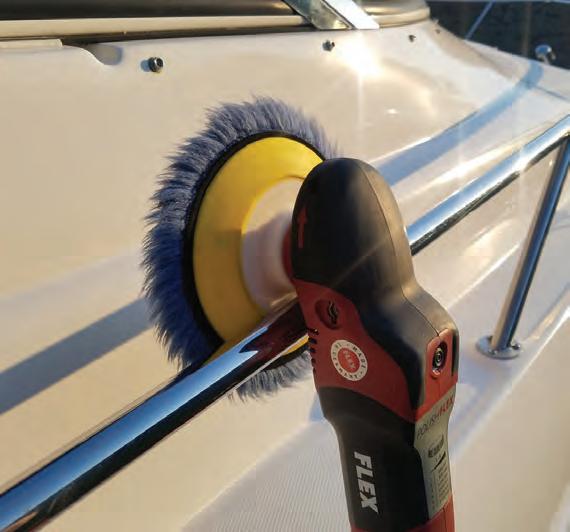



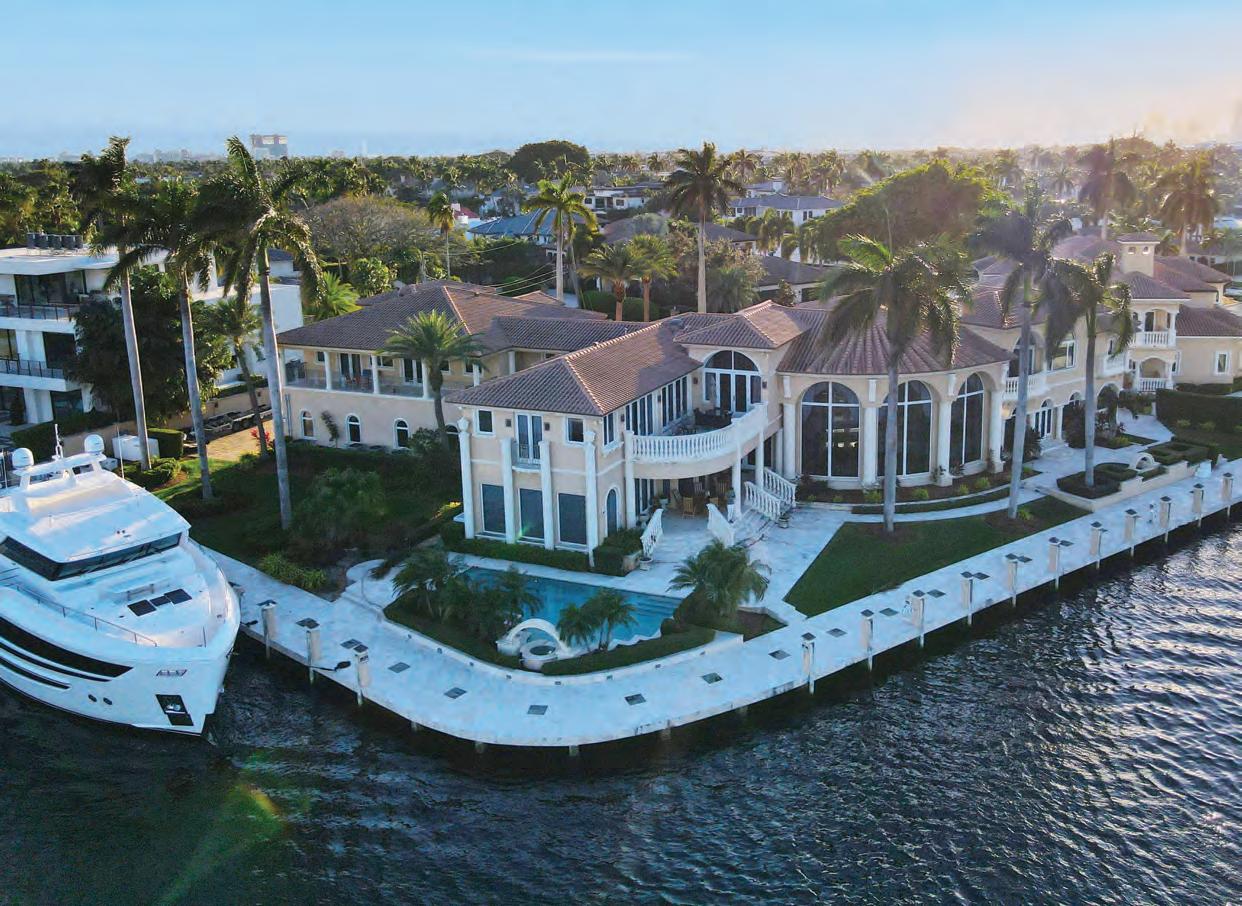






On a cool clear morning my fishing brother Stephen Leo and I were heading out of our home port of Jupiter inlet for a day’s fishing. Every angler I know has the giftof eternal optimism, and on this day, we were particularly excited about our prospects. Little did we know we’d stumble on the “Holy Grail” of fishing. About sixteen miles offthe coast, we came upon an unmoored marker buoy of signifiant size – not something you see every day. We could barely contain our excitement!
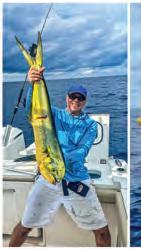

By Mark Ambert

For the uninitiated, fiding any kind of debris can be a godsend to the offhore, blue water angler. Especially anything of substance that has been in the water for a while and long enough to have an active marine ecosystem. Under and around the buoy we could see various schools of aquatic species. Ths means all sorts of live bait and crustaceans that attract hungry predators!
Ths can occur on some pretty small flating objects such as a wooden pallet, boat cushion, or storm debris. Even fiding miscellaneous debris can lead to epic catches. Blue water anglers search long and hard for this. To fid something this large and teaming with life was a once in a lifetime opportunity. Ths incredible fid turned out to be more than memorable, producing some great action on some of our most coveted offhore target species. It was a day of fishing I’ll never forget.
Let’s back up a bit on the origins of this incredible story in the making.
The buoy we had found turned out to be a boundary marker that had broken loose from its moorings in Dry Tortugas National Park Florida and


































Capt. Weston Russell • www.reelintensefishin.com •561-310-2690
Welcome to the March fishing forecast for the Palm Beaches. Expect some great offhore fishing this month! Let’s talk about some of the fish that will making a pit stop along the edge of the stream. Blackfintuna will be hunting in low light conditions as these fish have great eyesight and will swim away from heavy leaders, so scale down your rigs. Tuna eat live bait, a live sardine or threadfinwill do the job. If you can’t catch any small bait, check with the local bait guys on VHF channel 68 as they sell goggle eyes and smaller bait too.
For the reef anglers, live bait will be the key to catching smoker kings and fast wahoo. Remember to scale down and use a small trace of wire. Ths time of year, fishing depths of 70’ to 175’ will allow you to catch all the fish we mentioned, so keep your eye on the fishfider.
Sailfishing will start to slow down along with the spinner sharks. If you’re looking to catch one before it’s over, get offthe couch and get the boat ready. Kite fishing is always the best bet for sailfish, but it’s also cool for spinners on the beach. Anchor the boat in a safe spot next to shore and let the kite fly. Spinners love to cruise at the shoreline and the kite will get your bait to that special spot on the beach. It’s also an awesome site to see a shark explode on a cut fillet hanging from the kite
Let’s not forget that March is a great time for swordfishing too. Capt. Brad Mills says, “Daytime fishing last March produced some monster fish”, with fish in the 250lb. range being caught from Jupiter to Palm Beach Inlet.
www.USHarbors.com Palm Beach, FL - Mar 2025



3
4
0.4 10:49 -0.1 6:35 6:26
9 Sun 6:19 2.3 6:30 2.2 12:25 0.3 7:34 7:27 10 Mon 7:16 2.4 7:28 2.3 12:51 -0.1 1:22 0.2 7:33 7:27 11 Tue 8:05 2.5 8:18 2.5 1:44 -0.2 2:11 0.1 7:31 7:28
Wed 8:46 2.5 9:02 2.5 2:30 -0.2 2:53 -0.1 7:30 7:28
Thu 9:23 2.6 9:41 2.6 3:12 -0.2 3:32 -0.2 7:29 7:29

If you’re planning your fist daytime swor hire a guide. Ths will get you going in the right direction an money in the long run.
Thank you for taking the time to read this and remember you can’t catch them from the couch!
27































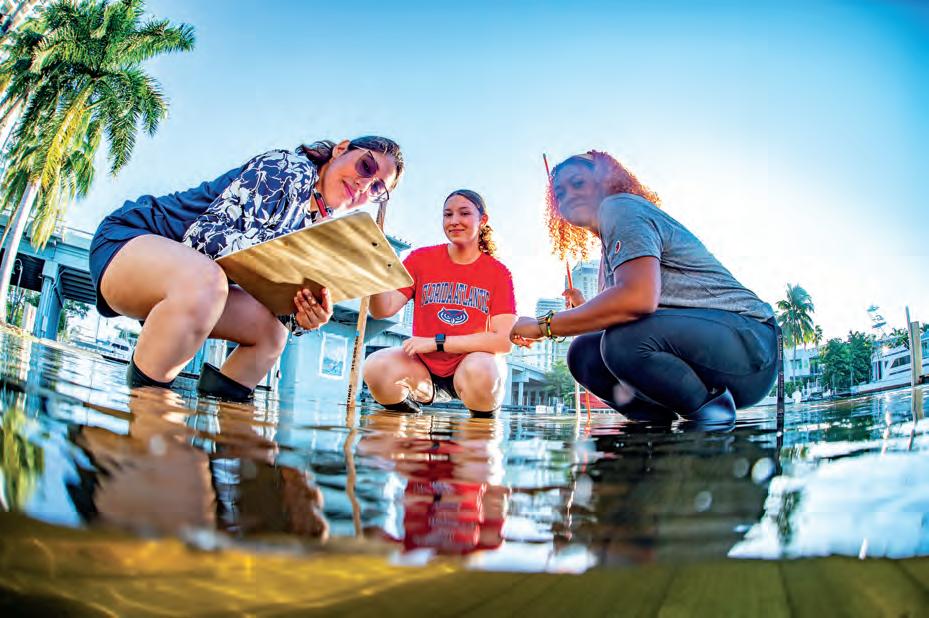


Educating the next generation of environmental leaders
Driving cutting-edge research for a resilient tomorrow
Protecting South Florida's unique ecosystems
Unlock Your Potential with ECOS:
• Undergraduate scholarships
• Dedicated advisors and mentors
•Research stipends, paid internships and grants
• Travel and professional development
•Professor in residence program fau.edu/ecos





March into spring! Warm weather and warm water temps will create fantastic fishing conditions. March is also the start of the spring mullet run, which triggers spectacular snook and tarpon fishing, as well as jacks, sharks, and many other species.
The snook fishing will be fantastic as snook begin to trickle from back


bays and begin to settle on flats, docks, sea walls, and local inlets. Moving water is the key for successful snook fishing. Live bait, Rapala X-Raps, and D.O.A. 3” Shad Tails are all excellent baits to get the strike. Nighttime snook fishing is another option for those looking to sight cast to an abundance of snook under dock lights and shadow lines. Flyfishing is the preferred method for night fishing, but artifical baits work as well.
Tarpon, a.k.a. the silver king, can be found roaming deep channels, mangrove shorelines, and sea walls. The juvenile tarpon are more prevalent in the back waters and the big 40 to 90-pound tarpon will be in the deep channels near inlets and beaches. Live bait free lined with the current is a great way to get hooked up. Artifical baits, like the D.O.A. TerrorEyz and the 5” Rapala X-Rap also works great. Remember, always bow to the king!
Anglers looking for a plethora of species to tango with channels, deep holes, and flats will be teeming with fish. You will fid jacks, bluefish, pompano, ladyfish, black drum, snapper, sharks, and many other species that will get the drag screaming. D.O.A. C.A.L. Curl Tails and live shrimp are the baits of choice.
Well, that is the fishing forecast for March. Hope you all enjoyed. Remember, you can’t catch them from the couch, so get out there and get hooked up. Tight lines!














































March is here and the winds may come with it, but I think every angler should use the wind as your friend instead of as your enemy. I love winds up to 25 miles per hour but over that I only like it when I am in back creeks where I don’t really feel it. Winds also bring lower and higher water during tides. If the tide is going out and the wind is blowing the same way, then the tide should get lower than normal, and if the tide is coming in and the wind is blowing in, you may get a higher tide than normal, where the saltwater goes deeper into the backcountry or vice versa. Usually this means some fish will go deeper into the backcountry including bait with fish following the bait. I also think about wind coming in and the tide going out, where this would make a slower than normal water flw, which I usually don’t like. In Flamingo Everglades National Park, a heavy west wind on the west coast usually makes the water very muddy which the fish don’t seem to like to feed or stay in. I consider all these things as a Charter Guide before my trips, as I usually know if it’s going to be a good day based on the tides and the wind and location that I’m going


to. Let’s say we have a weak tide and no wind so I’m going to usually go outside because the tide will flw the strongest on the outside islands. East Cape, Shark River, or Ponce de Leon Bay and all areas way inside will have a very weak tide flw. Although I try different things, I know where my best luck will be. On a heavy wind and big tide flw day, I know outside might be muddy unless the tide is switching, so I will go way inside like Whitewater Bay, Tarpon Bay, Coot Bay, and North Prong areas. I hope this information helps you think about where you go the night before your trip to Flamingo Everglades National Park or taking a charter with Florida Flats Fishing Adventures. Thank you for reading this article and until next time keep your lines tight and fish often. I hope to see you soon on the water in the Everglades National Park.






The City of Hollywood, strategically located between Miami and Fort Lauderdale, offers a prime South Florida hub for business. As a cornerstone of the marine industry, Hollywood provides unrivaled access to international markets for importing and exporting. Tap into global opportunities and connect with customers and suppliers worldwide from this prime location.

We’re celebrating 100 years of growth, innovation, and success— and now’s your chance to be part of Hollywood’s next 100 years! With a thriving economy, strategic location, and business-friendly environment, there’s never been a better time to establish your business in Hollywood.

• Prime South Florida Location
• Industrial Use Zoning In-Place
• 7 Miles of Sandy Beach, 2.5-Mile Beachfront Broadwalk
• 30 Miles of Navigable Waterways
• Economic Development Incentives
• No Personal Income Tax & Low Corporate State Tax
• Site Selection & Market Research Assistance











• Great Customer Service
• Unlimited Range Time
• Florida Concealed Weapons Classes
• FiReaRmS TRaininG CouRSeS Beginner to advanced & Private Classes Provided by Florida Firearms Training
• Fully air Conditioned Range
• maintained at 72 Degrees















































































March marks the beginning of one of the best fishing months of the year here in South Florida, and particularly in the Fort Lauderdale area. As the weather warms up and the water temperatures rise, anglers are in for an actionpacked fishing season. The influx of baitfish into local waters makes for some exceptional fishing opportunities, with a wide variety of species actively feeding and eager to strike.



For those joining us on our drift fishing trips, March is a particularly exciting time. The warmer waters bring a variety of snapper species, including mutton snapper, mangrove snapper, and yellowtail snapper. These species are often found in deeper waters, but our experienced crew knows the best spots to target for consistent action. Additionally, grouper, porgies, kingfish, and plenty of grunts make their appearance, offering anglers a chance to reel in some delicious, high-quality catches. Whether you’re a seasoned angler or just looking for a fun day on the water, the steady action and variety of species will ensure a great time.
If you’re looking for something more adventurous, our sportfishing trips in March are always a highlight. The warmer waters bring in a mix of big game fish, including sharks, mahi mahi, kingfish, barracuda, sailfish, and the ever-impressive amberjack. These fish are often found in deeper, blue-water areas, so trolling lures and spotting debris in the ocean become key strategies. Mahi mahi, known for their vibrant colors and acrobatic fihts, are a particular highlight this time of year. Keep your eyes peeled for flating debris as it often holds baitfish, which in turn attract larger predators, making for an exciting day of fishing.
March is truly one of the prime months for offhore fishing in South Florida, and Fort Lauderdale is at the heart of the action. Whether you’re drift fishing inshore or sportfishing in the deep blue, there are plenty of opportunities to reel in some trophy fish. Our crew is ready to ensure you have an unforgettable day on the water, whether you’re chasing big game or enjoying the steady bite of snapper species.
Don’t miss out on the fantastic fishing this March. Call us today or book your trip online and get ready to experience some of the best fishing South Florida has to offer!



Make steak the catch of the day with a celebratory stop at Ruth's Chris. After a day on the water, join us for signature sizzle, hand-crafted cocktails and legendary hospitality.
PONTE VEDRA BEACH
814 A1A N., Suite 103 Ponte Vedra Beach, FL 32082 904-285-0014
JACKSONVILLE
1201 Riverplace Blvd. DoubleTree by Hilton Hotel, Jacksonville, FL 32207 904-396-6200
DESTIN
924-A-Senate Street, Destin, FL 32541 850-837-7884
ORLANDO 7501 W. Sand Lake Rd. Orlando, FL 32819 407-226-3900
WINTER PARK
480 N. Orlando Ave. Suite 100B Winter Park, FL 32789 407-622-2444
LAKE MARY
80 Colonial Center Pkwy. Lake Mary, FL 32746 407-804-8220
TAMPA 1700 N. Westshore Blvd. Tampa, FL 33607 813-282-1118
ST. PETERSBURG
131 2nd Ave. N. St. Petersburg, FL 33701 727-821-4139
SARASOTA
6700 S. Tamiami Trail Sarasota, FL 34231 941-924-9442
LAKEWOOD RANCH
6490 University Pkwy. Sarasota, FL 34240
941-315-6669
WEST PALM BEACH 651 Okeechobee Blvd. West Palm Beach, FL 33401 561-514-3544
BOCA RATON 225 NE Mizner Blvd. Suite 100 Boca Raton, FL 33432 561-392-6746
BONITA SPRINGS 23151 Village Shops Way Suite 101, Coconut Point Mall Bonita Springs, FL 33928 239-948-8888
FORT LAUDERDALE
2525 N. Federal Hwy Fort Lauderdale, FL 33305 954-565-2338
AVENTURA
2980 NE 207th St. Aventura, FL 33180 305-912-1266
CORAL GABLES
2320 Salzedo St. Coral Gables, FL 33134 305-461-8360
JUPITER
105 Breakwater Ct, Jupiter, FL 33477 561-831-4440









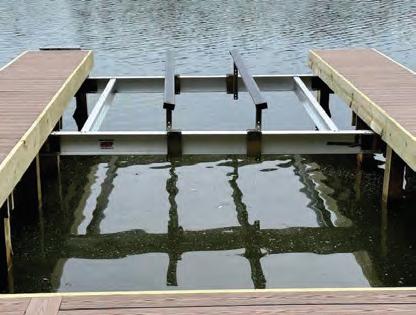




ShoreStation hydraulic boat lifts are a reliable choice for coastal residents and boating enthusiasts alike. Their strong construction, made with corrosion-resistant materials, allows them to withstand harsh environmental conditions, including sun, storms, and saltwater damage. ShoreStation provides a steadfast solution for protecting waterfront investments, o ering peace of mind to owners in the Sunshine State.
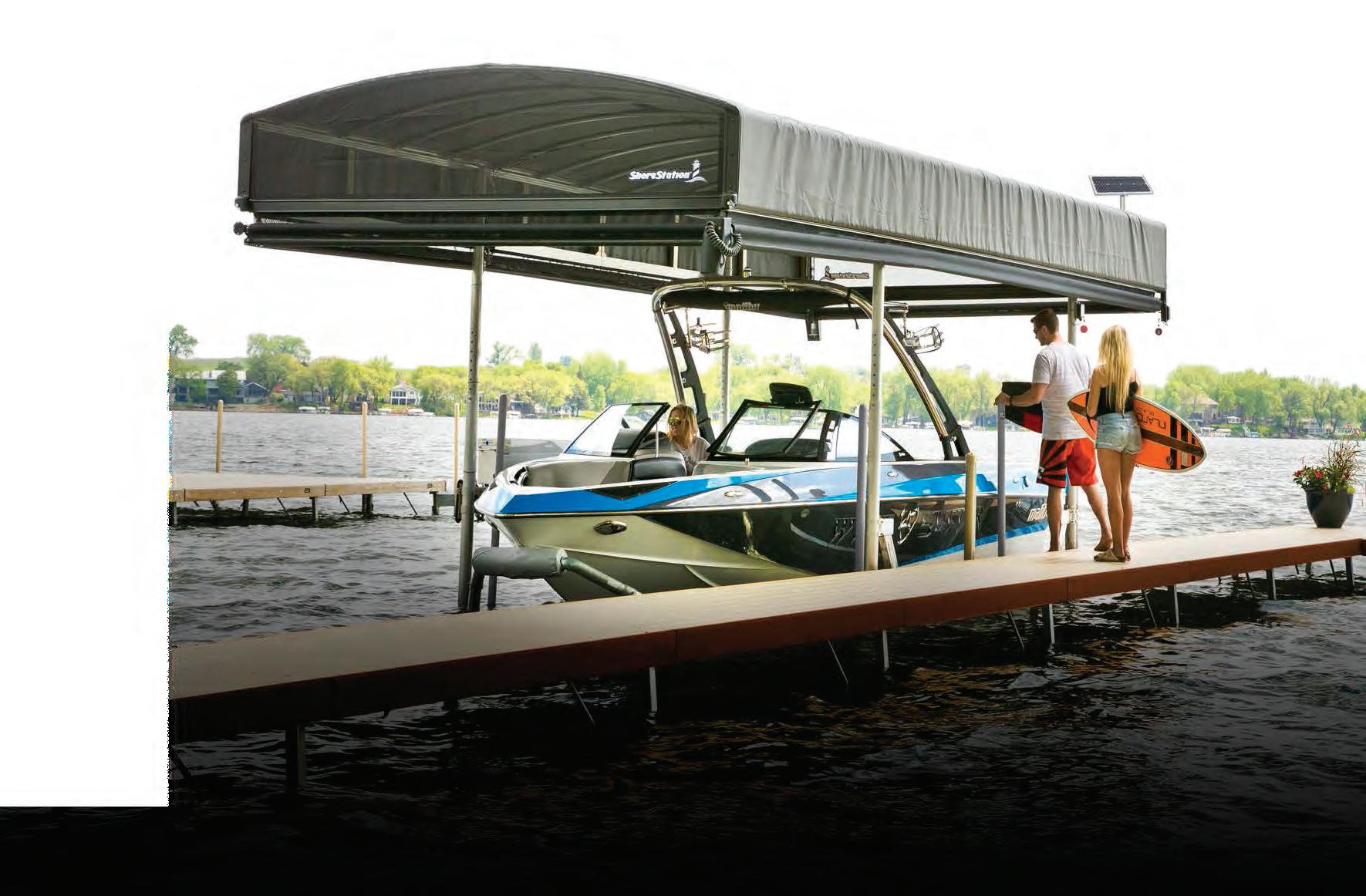







Equipped with exceptional weather resistant fabric and breathable SunTex 80 woven mesh ends for maximum protection and durability, the REVOLUTION™ Series Canopy is the most innovative canopy

Made from the highest quality materials, our innovative hydraulic boat lift is one of the fastest and safest lifts on the market today. When you have a hydraulic lift, there’s no need to worry about wind and waves getting in your way. This lift will give you con dence to safely land and secure your boat in less-than-ideal conditions.
Never miss another moment on the water. Power your lift with clean, free solar power. Our speedy 20 watt charger features solar regulator drainage protection, saving your battery from permanent damage caused by overcharging.



By Capt. Michael Okruhlik

Spring shing brings its own set of challenges and opportunities. As water temperatures rise, targeting inshore species like trout, ounder, and reds requires adapting to their changing behavior. Early spring o en means downsizing lures. As sh feed on tiny bait sh and shrimp, small lures mimic these natural prey more e$ectively. Large trout and reds may already have full stomachs, expelling small bait when caught, signaling the need for a smaller o$ering to match the size of the food they’re consuming.
With the warming water, sh become more aggressive, and it’s time to speed up your retrieval techniques. A er a slower winter, anglers should bring out faster-action rods and smaller versions of topwater and twitch baits. While spring can bring calm days, cool fronts and high-pressure systems still a$ect sh behavior. When this happens, adjusting to the conditions—rather than just relying on the calendar—is key. Opting for colors like white or silver for hard baits can pay o$ during this time.
However, spring also brings sti$ winds and crowds. In South Texas, gusts can reach up to 30 knots, making conditions challenging, especially

for kayakers. It’s crucial to check the forecast and plan for these challenging winds. Additionally, spring break brings an in ux of boaters and kayakers, many of whom may be rusty from the o$season. Defensive driving and boating have become essential, and leaving early is recommended to avoid congestion at ramps and on the roads.
Conditions are still variable when targeting sh in March. %e water can remain chilly despite warmer air temperatures. Cold fronts a$ect sh behavior, making them seek deeper water with more stable temperatures. While some sh may move closer to ats as the day warms, they rarely stray far from deep water. Focus on areas near the outer edges of guts that lead from deeper water to ats, adjusting as the day progresses.
During high-pressure conditions, downsizing lures remains reliable, especially as young forage species become abundant. Natural or translucent
colors work well; slowing the retrieval to keep lures closer to the bottom can increase success. When this approach doesn’t yield results, switching tactics can help. Using noisy lures, such as rattling crankbaits or loud topwaters, can provoke a reaction bite when sh are less willing to chase actively. Experimenting with these extremes—quiet, slow presentations versus noisy, aggressive ones—can help you nd the right approach in high-pressure situations. Spring shing requires patience, adaptability, and a keen eye for weather and water conditions. Whether you’re dealing with shi ing sh patterns or navigating spring break crowds, it’s a great time to get out on the water—and maybe bring a kid along for the adventure.
Capt. Michael Okruhlik is the inventor of Knockin Tail Lures®, and the owner of www.MyCoastOutdoors.com.



I’ve been incredibly blessed to !sh with some of the best anglers on the planet, guiding me through my journey. To complete that journey, I always keep a couple of rods in my truck, ready to !sh farm ponds, lakes, and rivers during my travels as a Boat Li US salesman. It brings me back to my roots.
Last month marked my 64th birthday, and I !nd myself enjoying the simple !shing of my youth more and more. Don’t get me wrong—I still love a gag grouper or wahoo bite like Peter loved our Lord—but I also love catching whatever is in season. March can be a slow month for nearshore and o shore !shing, making it the perfect time to switch focus to hickory and white (American) shad in our rivers.
Tim Barefoot

their birth. eir migration mirrors that of Paci!c salmon, using an innate
learning their seasons over the years. Hickory shad arrive !rst—smaller but plentiful—making them perfect for introducing kids to !shing with non-stop action. When the larger white shad show up, it’s game on. ese !sh pull hard in the cold water, !ghting until the moment you unhook them.
I strongly recommend mashing down the barbs on your hooks to make dehooking easier. Let’s be honest—most anglers aren’t eating shad, so reducing injury before release just makes sense. Also, always wear eye protection when !shing for these powerful !sh. A jig popping free near the boat can come ying back at the angler, as my son learned the hard way in a recent trip to the James River.

ese !sh are truly amazing. ey leave the coastal rivers of the eastern U.S., migrate to Nova Scotia, take a hard right into deep waters, then journey back south to spawn in the rivers of
GPS to !nd their way home. ey travel in vast schools, surviving intense predation, just to return to their spawning grounds.
Knowing this, I position myself to take full advantage of this mass migration. I !sh for shad in Virginia, North Carolina, and South Carolina,
White shad will be in rivers all the way down to Florida this month, so if you’re looking for a fun !ght on light tackle, now is the time. Check out my YouTube channel for the tackle and techniques I use to catch these childhood favorites. And, as always, take plenty of videos of your kids—they’ll cherish those memories later in life.
For more from Tim Barefoot, visit barefootcatsandtackle.com and check out his YouTube channel.



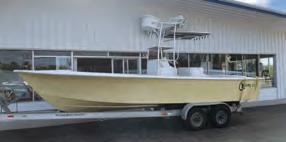








May 9th & 10th, 2025
Online Registration: MothersDayDolphinTournament.com
Captain’s Meeting
Liechty Marine
Friday May 9th - 6pm to 7pm
Lines In: Saturday, May 10 - 7:30am
Lines Out: Saturday, May 10 - 3:30pm
Weigh-In
Curly’s Co ee
Saturday, May 10th - 3:30pm to 6pm
Awards Banquet
Marathon Yacht Club
Saturday, May 10th - 7pm
Sunday Honor

















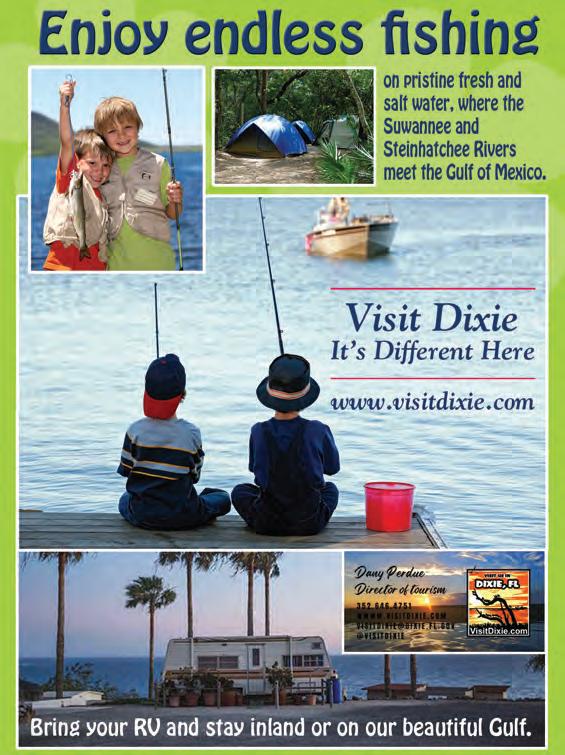













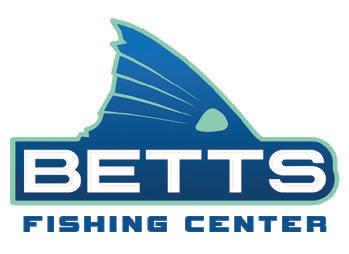


From February through April, bass ood the shallows to spawn, creating an exciting opportunity for anglers to catch monster !sh. While various techniques can be e ective, !shing with a big worm consistently tempts big, wary females. is method has proven successful nationwide, not just in the South.
Fishing a worm may not be the most thrilling technique, but it allows for a slow, precise presentation—ideal for enticing cautious bass. e key is patience and targeting highpercentage areas where these !sh are likely holding.
One e ective technique is casting a Texasrigged stick bait. Many anglers waste time on unproductive water, but focusing on isolated cover—small patches of grass, pads, wood, or rock structures—maximizes success. A 6” worm in darker colors like black-and-blue works well, paired with a 1/16 oz or 1/8 oz weight for a natural presentation. Given the thick cover, 17-20 lb uorocarbon is ideal for strength and stealth.
Another productive method is retrieving a big speed worm. is subtle, vibrating motion excites bass and helps locate !sh before slowing down for precision tactics. In stained water, darker shades like June bug work best, while

TYLER WOOLCOTT

green pumpkin with ake is ideal for clear water. A 1/8 oz to 1/4 oz weight with 15-17 lb uorocarbon balances presentation and control.
e wacky rig is highly e ective in shallow water, particularly for pressured bass. is weightless presentation targets isolated cover, making it a deadly !nesse option. A 10-15 lb uorocarbon leader on a spinning setup provides the necessary balance of stealth and strength. As with other worm techniques, darker colors suit stained water, while natural tones excel in clear conditions.
Flipping a worm is less stealthy but allows precise bait placement in thick cover, such as pad !elds, wood, or dense grass. is method is excellent for working through cover quickly while thoroughly breaking down key sections. Using large Senko-style baits and braided line ensures maximum strength. Weight selection varies from 3/8 oz to 3/4 oz, depending on cover density. Slowing down and targeting overlooked spots can set you apart from other anglers.
Rod and reel choices remain fairly consistent across these techniques. For casting and ipping, a 7’6” medium-heavy to heavy action rod, such as the 13 Fishing Omen Series, paired with a high-speed baitcasting reel like the Concept

A 7:5:1, ensures control and power. For wacky rigs, a 7’3” medium-heavy spinning rod with a quality reel like the 13 Fishing Axum provides sensitivity and strength.
ese big worm techniques have helped me land giants during the spawn, and I hope they do the same for you. Whether !shing Florida’s grass beds or rocky northern structures, these methods are time-tested and e ective. Get out there this spring and hook into some monster bass!
Tyler Woolcott is a professional tournament angler and guide. Check out his website at www.tylerwoolcott shing.com.
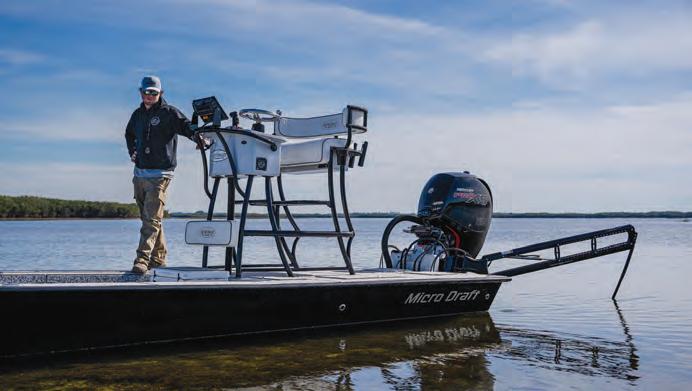










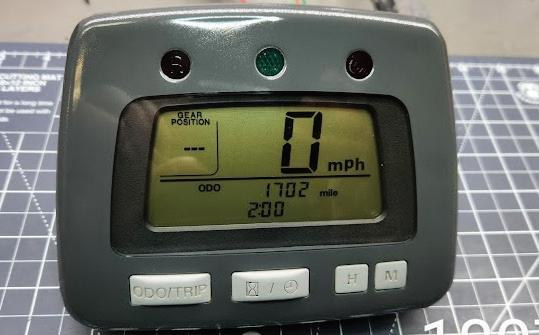









In the misty Scottish Highlands, where mountains meet shimmering lochs, the dirk dagger has been a symbol of heritage and honor for centuries. Originating in the medieval battles and clan rivalries, these daggers were not just weapons but treasured heirlooms passed through generations.
One stormy night, a young warrior named Ewan was called to the forge by his grandfather, Duncan, a revered blacksmith. “Ewan,” he began, “our clan’s strength lies not only in our courage but in the blades we wield. Tonight, you will learn the art of crafting a dirk that will carry our legacy forward.”
Ewan selected premium Damascus steel, layering it over 242 times to create a blade with intricate, swirling patterns reminiscent of ancient Highland rivers. Each fold whispered stories of battles won and lost, of honor and sacrifice. He crafted a classic spear point blade with a ¾ tang for enhanced strength and balance, ensuring it stood the test of time and combat.


The handle was crafted from solid Micarta, a material as resilient as the Scottish spirit. Adorned with stainless steel and brass file work, the spacers and guard shimmered like northern stars. The rounded pommel provided perfect balance and a textured grip, making it feel like an extension of Ewan’s hand.
As dawn broke, Ewan held the completed dirk in his hands. Measuring 12 inches overall, with a 7-inch blade, it was more than a weapon; it was a tribute to his ancestors and a beacon of his clan’s legacy.


Ewan’s dirk became legendary, said to cut through the strongest armor, with patterns holding the essence of the Highlands. Today, the Damascus Spiral Dirk Knife stands as a pinnacle of craftsmanship, a modern marvel carrying the spirit of ancient Scottish warriors. It is a legacy reborn, ready to be part of your collection, where every inch tells a story of dedication, tradition, and excellence.
Embrace the legend. Hold the history. Own the Damascus Spiral Dirk Knife today for just $99 plus S&H when using special offer code CA5MDK at checkout. This offer is limited to the first 1,200 orders so be sharp and call up today!
Specifications:
Overall Length: 12”
Blade Length: 7”
Blade Material: Premium Damascus steel, layered over 242 times Tang: ¾ tang for enhanced performance
Handle Material: Solid Micarta with stainless steel and brass file, worked spacers and guard Pommel: Rounded for balance and ergonomic grip
Damascus Spiral Dirk Dagger Knife
Was - $249
Now Only - $99 (plus S&H)
Use o er code: CA5MDK
*California residents please call 1-800 733 8463 regarding Proposition 65 regulations before purchasing this product.





